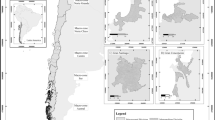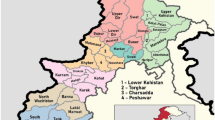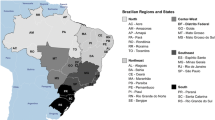Abstract
In India, very high disparities exist among different regions, states, and social groups in social, economic, political, and historical factors, leading to differential social vulnerability to disasters. This paper seeks to identify the determinants of social vulnerability in India and the most vulnerable districts using the inductive approach at the district level. The study attempts to assess the regional differences in social vulnerability across districts of India, and it also related these differences to the size of the states. For a better and in-depth understanding of social vulnerability, it has been divided into Socioeconomic and Infrastructural vulnerability. The study found that socioeconomic vulnerability is more pronounced than infrastructural vulnerability, and there are significant regional differences in the degree of social vulnerability within the country. ANOVA analysis and spatial autocorrelation techniques signify a concentration of vulnerability in districts belonging to bigger states, especially the "Empowered Action Group" states which are located in India's Central and East Zones. The main determinants of social vulnerability are found to be dependence on the agricultural and allied sector, the proportion of economically and socially dependent population, levels of education and work participation, and access to basic assets and infrastructure. The most vulnerable districts identified in the study are predominantly tribal districts and require effective interventions to reduce their vulnerability. The study can find wide applications in district-level planning and identifying targets for vulnerability reduction.

Source: Authors’ preparation using QGIS.

Source: Authors’ preparation.




Similar content being viewed by others
Notes
Main workers- worked for more than six months in the year preceding the date of enumeration of the data source (Definition by Census of India,2011).
Marginal workers- worked for less than six months in the year preceding the date of enumeration of the data source (Definition by Census of India,2011).
Agricultural and allied sector in India consists of cultivators and agricultural laborers, workers in plantation, livestock, forestry, fishing, hunting, and allied activities etc.
References
Acosta-Michlik, L., Galli, F., Klein, R. J., Campe, S., Kavi Kumar, K. S., Eierdanz, F., & Tänzler, D. (2005). How vulnerable is India to climatic stress? Measuring vulnerability to drought using the Security Diagram concept. In IHDP GECHS International Workshop “Human Security and Climate Change". Asker, Norway.
Adger, W. N., & Agnew, M. (2004). New indicators of vulnerability and adaptive capacity (Vol. 122). Norwich: Tyndall Centre for Climate Change Research.
Aksha, S. K., Juran, L., Resler, L. M., & Zhang, Y. (2019). An Analysis of social vulnerability to natural hazards in nepal using a modified social vulnerability index. International Journal of Disaster Risk Science, 10(1), 103–116. https://doi.org/10.1007/s13753-018-0192-7
Anselin, L. (2003). An introduction to spatial autocorrelation analysis with GeoDa. University of Illinois, Champagne-Urbana, Illinois.
Antwi-Agyei, P., Dougill, A. J., Fraser, E. D. G., & Stringer, L. C. (2013). Characterising the nature of household vulnerability to climate variability: Empirical evidence from two regions of Ghana. Environment, Development and Sustainability, 15(4), 903–926. https://doi.org/10.1007/s10668-012-9418-9
Azhar, G., Saha, S., Ganguly, P., Mavalankar, D., & Madrigano, J. (2017). Heat wave vulnerability map** for India. International Journal of Environmental Research and Public Health, 14(4), 357.
Bahinipati, C. S. (2014). Assessment of vulnerability to cyclones and floods in Odisha, India: a district-level analysis. Current Science, pp. 1997–2007.
Barua, S., Saikia, N., & Sk, R. (2021). Spatial pattern and determinants of diagnosed diabetes in southern India: evidence from a 2012–13 population-based survey. Journal of Biosocial Science, 53(4), 623–638. https://doi.org/10.1017/S0021932020000449
Bergstrand, K., Mayer, B., Brumback, B., & Zhang, Y. (2015). Assessing the relationship between social vulnerability and community resilience to hazards. Social Indicators Research, 122(2), 391–409.
Bhattacharya, B. B., & Sakthivel, S. (2004). Regional growth and disparity in India: Comparison of pre-and post-reform decades. Economic and Political Weekly, pp. 1071–1077.
Botero, D. G., & Salinas, A. B. (2013). Assessing farmers’ vulnerability to climate change: A case study in Karnataka, India. UAB Universitat Autonoma de Barcelona, Spain.
Chakravarty, S., & Dand, S. A. (2005). Food insecurity in India: causes and dimensions.Indian Institute of Management Working Paper. Available at: http://hdl.handle.net/11718/6274
Chatterjee, E., Desai, S., & Vanneman, R. (2018). INDIAN PARADOX: RISING EDUCATION, DECLINING WOMENS’EMPLOYMENT. Demographic Research, 38, 855.
Cutter, S., Emrich, C., Webb, J., & Morath, D. (2009). Social vulnerability to climate variability hazards: a review of the literature. Hazards and Vulnerability Research Institute, pp. 1–44.
Cutter, S. L., Boruff, B. J., & Shirley, W. L. (2003). Social vulnerability to environmental hazards. Social Science Quarterly, 84(2), 242–261.
Das, A. (2013). “Map** the regional variation in potential vulnerability in Indian Agriculture to climate change”- An exercise through constructing vulnerability index. African Journal of Environmental Science and Technology, 7(4), 112–121. https://doi.org/10.5897/AJEST10.288
Das, S., Hazra, S., Haque, A., Rahman, M., Nicholls, R. J., Ghosh, A., & de Campos, R. S. (2021). Social vulnerability to environmental hazards in the Ganges-Brahmaputra-Meghna delta, India and Bangladesh. International Journal of Disaster Risk Reduction, 53, 101983.
de Loyola Hummell, B. M., Cutter, S. L., & Emrich, C. T. (2016). Social vulnerability to natural hazards in Brazil. International Journal of Disaster Risk Science, 7(2), 111–122. https://doi.org/10.1007/s13753-016-0090-9
de Sherbinin, A., & Bardy, G. (2015). Social vulnerability to floods in two coastal megacities: New York City and Mumbai. Vienna Yearbook of Population Research, 13(1), 131–166. https://doi.org/10.1553/populationyearbook2015s131
ESCAP (2021). Risk and Resilience Portal. Accessed from https://rrp.unescap.org/hazard-hotspots/climate-related-and-biological-multi-hazard
Frigerio, I., Carnelli, F., Cabinio, M., & De Amicis, M. (2018). Spatiotemporal pattern of social vulnerability in Italy. International Journal of Disaster Risk Science, 9(2), 249–262. https://doi.org/10.1007/s13753-018-0168-7
Füssel, H. M. (2007). Vulnerability: A generally applicable conceptual framework for climate change research. Global Environmental Change, 17(2), 155–167.
GOI (2011). Census of India. New Delhi: Office of the Registrar General and Census Commissioner.
GOI. (2020). SRS Bulletin. Accessed from. https://www.censusindia.gov.in/vital_statistics/SRS_Bulletins/Bulletins.html
GoI.(2012).India Second National Communciation to the United Nations Framework on climate Change.New Delhi: Ministry of Environment & Forests,Government of India.
Holand, I. S., Lujala, P., & Rod, J. K. (2011). Social vulnerability assessment for norway: A quantitative approach. Norsk Geografisk Tidsskrift, 65(1), 1–17. https://doi.org/10.1080/00291951.2010.550167
International Institute for Population Sciences (IIPS) and ICF. (2017). National Family Health Survey (NFHS-4), 2015–16: India. Mumbai: IIPS
Jahangir, D. (2011). Regional disparities in economic development in the postreform period.Ph.D. thesis.Aligarh Muslim University.Available at: http://hdl.handle.net/10603/12950
Karat, B., & Rawal, V. (2014). Scheduled tribe households: A note on issues of livelihood. Review of Agrarian Studies, 4(2369–2021–073).
Kelly, P. M., & Adger, W. N. (2000). Theory and practice in assessing vulnerability to climate change andFacilitating adaptation. Climatic Change, 47(4), 325–352.
Khan, J., Shil, A., & Prakash, R. (2018). Exploring the spatial heterogeneity in different doses of vaccination coverage in India. PLoS ONE, 13(11), e0207209.
Letsie, M. M., & Grab, S. W. (2015). Assessment of social vulnerability to natural hazards in the mountain kingdom of Lesotho. Mountain Research and Development, 35(2), 115–125. https://doi.org/10.1659/mrd-journal-d-14-00087.1
Maiti, S., Jha, S. K., Garai, S., Nag, A., Bera, A. K., Paul, V., & Deb, S. M. (2017). An assessment of social vulnerability to climate change among the districts of Arunachal Pradesh, India. Ecological Indicators, 77, 105–113. https://doi.org/10.1016/j.ecolind.2017.02.006
Maiti, S., Jha, S. K., Garai, S., Nag, A., Chakravarty, R., Kadian, K. S., & Upadhyay, R. C. (2015). Assessment of social vulnerability to climate change in the eastern coast of India. Climatic Change, 131(2), 287–306. https://doi.org/10.1007/s10584-015-1379-1
Mavhura, E., Manyena, B., & Collins, A. E. (2017). An approach for measuring social vulnerability in context: The case of flood hazards in Muzarabani district, Zimbabwe. Geoforum, 86, 103–117. https://doi.org/10.1016/j.geoforum.2017.09.008
Mazumdar, J., & Paul, S. K. (2016). Socioeconomic and infrastructural vulnerability indices for cyclones in the eastern coastal states of India. Natural Hazards, 82(3), 1621–1643. https://doi.org/10.1007/s11069-016-2261-9
Morzaria-Luna, H. N., Turk-Boyer, P., & Moreno-Baez, M. (2014). Social indicators of vulnerability for fishing communities in the Northern Gulf of California, Mexico: Implications for climate change. Marine Policy, 45, 182–193.
NIDM.(2014). India. Accessed at https://nidm.gov.in/easindia2014/err/pdf/country_profile/India.pdf
O’BRIENEriksenNygaardSchjolden, K. A. R. E. N. S. L. P. A. N. E. (2007). Why different interpretations of vulnerability matter in climate change discourses. Climate Policy, 7(1), 73–88.
Ohlan, R. (2013). Pattern of regional disparities in socio-economic development in India: District level analysis. Social Indicators Research, 114(3), 841–873.
Ray-Bennett, N. S. (2009). The influence of caste, class and gender in surviving multiple disasters: A case study from Orissa India. Environmental Hazards, 8(1), 5–22.
Romero-Lankao, P., Gnatz, D. M., & Sperling, J. B. (2016). Examining urban inequality and vulnerability to enhance resilience: Insights from Mumbai India. Climatic Change, 139(3–4), 351–365. https://doi.org/10.1007/s10584-016-1813-z
Rufat, S., Tate, E., Burton, C. G., & Maroof, A. S. (2015). Social vulnerability to floods: Review of case studies and implications for measurement. International Journal of Disaster Risk Reduction, 14, 470–486.
Schelhas, J., Hitchner, S., & Johnson, C. (2012). Social vulnerability and environmental change along urban-rural interfaces. Urban-Rural Interfaces: Linking People and Nature. https://doi.org/10.2136/2012.urban-rural.c11
Sendhil, R., Jha, A., Kumar, A., & Singh, S. (2018). Extent of vulnerability in wheat producing agro-ecologies of india: tracking from indicators of cross-section and multi-dimension data. Ecological Indicators, 89C, 771–780.
Siagian, T. H., Purhadi, P., Suhartono, S., & Ritonga, H. (2014). Social vulnerability to natural hazards in Indonesia: Driving factors and policy implications. Natural Hazards, 70(2), 1603–1617.
Thomas, K., Hardy, R. D., Lazrus, H., Mendez, M., Orlove, B., Rivera-Collazo, I., & Winthrop, R. (2019). Explaining differential vulnerability to climate change: A social science review. Wiley Interdisciplinary Reviews: Climate Change, 10(2), e565.
Turner, B. L., Kasperson, R. E., Matson, P. A., McCarthy, J. J., Corell, R. W., Christensen, L., & Schiller, A. (2003). A framework for vulnerability analysis in sustainability science. Proceedings of the National Academy of Sciences, 100(14), 8074–8079.
UNDRR & CRED (2020). Human Cost of Disasters: An overview of the last 20 years 2000–2019. CRED
Vincent, K. (2004). Creating an index of social vulnerability to climate change for Africa. Tyndall Center for Climate Change Research. Working Paper, 56(41), pp. 1–50.
Vittal, H., Karmakar, S., Ghosh, S., & Murtugudde, R. (2020). A comprehensive India-wide social vulnerability analysis: highlighting its influence on hydro-climatic risk.". Environmental Research Letters, 15, 014005.
Wigtil, G., Hammer, R. B., Kline, J. D., Mockrin, M. H., Stewart, S. I., Roper, D., & Radeloff, V. C. (2016). Places where wildfire potential and social vulnerability coincide in the coterminous United States. International Journal of Wildland Fire, 25(8), 896–908.
Yenneti, K., Tripathi, S., Wei, Y. D., Chen, W., & Joshi, G. (2016). The truly disadvantaged? Assessing social vulnerability to climate change in urban India. Habitat International, 56(August), 124–135. https://doi.org/10.1016/j.habitatint.2016.05.001
Zou, L. L., & Wei, Y. M. (2010). Driving factors for social vulnerability to coastal hazards in Southeast Asia: Results from the meta-analysis. Natural Hazards, 54(3), 901–929.
Acknowledgements
The authors express our sincere gratitude to the Senior Research Fellowship provided by University Grants Commission, India to the first author for conducting doctoral research in the field of climate change.
Author information
Authors and Affiliations
Corresponding author
Ethics declarations
Conflict of interest
The authors declare that they have no known competing financial interests or personal relationships or employment that could have appeared to influence the work reported in this paper.
Additional information
Publisher's Note
Springer Nature remains neutral with regard to jurisdictional claims in published maps and institutional affiliations.
Appendix
Appendix
See Figs.
7,
8 and
See Tables
5,
6,
7,
8,
9,
10,
11,
12,
13 and
Rights and permissions
About this article
Cite this article
George, A., Sharma, P. Socioeconomic and infrastructural vulnerability of Indian population: a district level study. GeoJournal 88, 1841–1871 (2023). https://doi.org/10.1007/s10708-022-10712-6
Accepted:
Published:
Issue Date:
DOI: https://doi.org/10.1007/s10708-022-10712-6







